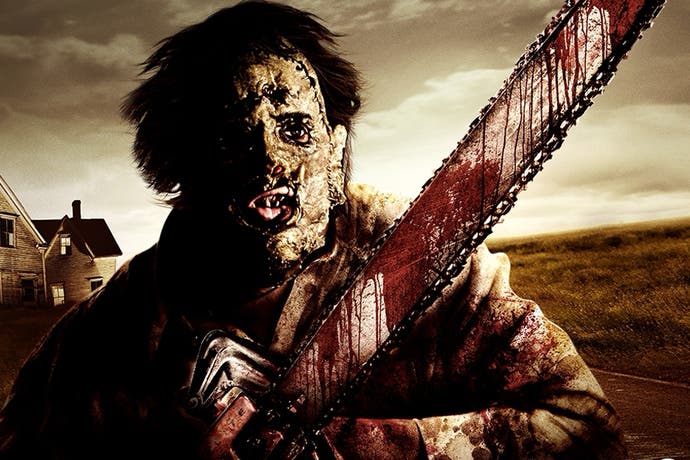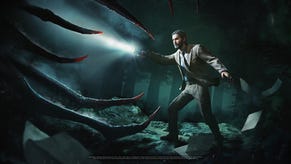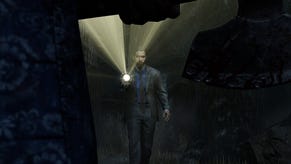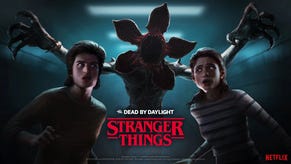Everything I learned about game design last year I learned from Dead by Daylight
We should definitely split up...
Sometimes I worry I'm a contrarian. People tell me I'm not, but I won't listen to them. Here's an example. Last year, while most of my peers were pouring hundreds of hours into Zelda and Super Mario Odyssey, I was completely obsessed with Dead by Daylight, an asymmetrical multiplayer horror game that almost no one else I knew was playing. Developed by Behaviour Interactive, it challenges four players to work together as survivors, avoiding the murderous intentions of a fifth player who takes part as the killer. During each bout, the survivors have to explore the map, find generators and fix them in order to power-up two exit doors and get the hell out of there. The killer just has to kill them.
Unlike the ostensibly similar Friday the 13th game, Dead by Daylight features a range of homicidal maniacs covering a range of movie tropes, from chainsaw-wielding rednecks to mad doctors - there are also licensed characters in the shape of Freddy Krueger and Michael Myers, and all of them have different attacks and abilities. The killing process involves capturing survivors then impaling them on meat hooks. If they're not rescued by other survivors within a short window of opportunity, a Lovecraftian beast claims the writhing victim.
Got that? It sounds sort of complicated doesn't it?
But it's not, it's very simple. This is a game about tension, teamwork and the psychology of fear. If you're a survivor, it's a staccato dance of stealth and stasis; you creep around the eerie semi-rural locations searching for generators and then standing by them while they slowly regenerate. This is the first interesting thing about the game design: there is a LOT of waiting. While you're fixing a generator you have about 30 seconds of game time where you're totally stuck; you're in a hacking mini-game, except the world is moving around you and you can be killed. You're able to look around though, and thanks to a heartbeat effect that accelerates if the killer is near, you can watch out for danger, but there's no getting away from the fact that you spend much of each game crouching in front of a machine.
It shouldn't work because most multiplayer game design is based around continual momentum. In shooters, to stop is to die, and even in the new Call of Duty War mode, which requires players to pause and, say, plant a bomb on a bridge, the planting sequence is over in seconds. By countering this, Dead by Daylight forces twitchy players to think, to plan and to visually investigate the environment. Most of all, though, it puts players in a state of heightened tension that perfectly replicates the dynamic of most slasher horror movies, which are not really about the murders, they're about what the characters do before they are murdered. They are about hiding and waiting. They are about killing time.
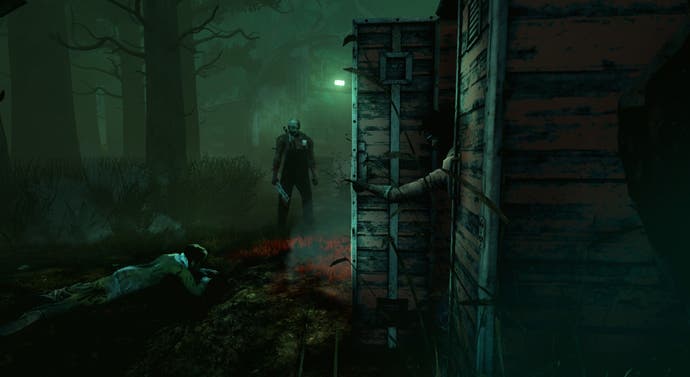
In this way, Dead by Daylight, which didn't review particularly well, is actually one of the most interesting horror games I've ever played, exploring elements of horror movie conventions - particularly hiding and waiting - that few other games even attempt.
Dead by Daylight is also about emergent group management and tactical altruism, which again are key elements of most slasher films. Watch Texas Chainsaw Massacre, Friday the 13th, Final Destination, Scream or Nightmare on Elm Street and you see that the dynamic between the (usually teenage) characters - the way their relationships build, fall and evolve as they become increasingly terrified - is an essential building block of the experience. It's also a dynamic that traditional narrative horror games have rarely tackled: Resident Evil, Silent Hill et al feature secondary characters, but the relationships are all scripted, and there are very rarely complex co-op options allowing players to interact with each other in a meaningful way. Dead by Daylight however is utterly built around the sorts of altruistic actions we find in horror fiction. Characters have to work together, guard each other, come up with plans and often risk their lives for each other as each bout takes place. Ingeniously, there's no way to attack the killer, so co-ordination is always passive - which heightens the tension yet again. Everyone is vulnerable. Furthermore, there are only two gestures with which to communicate (point and summon) so unless you're on party chat, relationships are wordless and instinctive
And yet, really interesting group mechanics emerge. I've been in games where players form incredibly close bonds, saving each other from the killer's hook over and over, and working together to fix generators while others look out or cause distractions. Of course, there are points available for players who take the risk to pull other survivors off the meat hooks, but I've seen moments of genuine self-sacrifice, where the risk of saving another was greater than the potential reward. Through these exchanges, the game explores forms of crowd behaviour in very interesting ways: you get bravery, you get examples of groupthink, but you also get moments where everyone assumes the other players will help someone who's been captured - a common quirk of human group psychology known as the diffusion of responsibility. In short, Dead by Daylight is about what people do when they're scared and don't know each other well enough. It's like a Lord of the Flies skinner box. But fun.
So for survivors, this game involves cooperation, stealth and stasis - you secure areas of a map and stay there a really long time, always in direct peril. For killers, meanwhile, it's about tracking other players and depositing them in goal areas, which is a completely different dynamic. You are essentially hunting. But there is another vital facet of their role: intimidation. Each of the killer characters has a quirk they can engage that lets players know they're coming - it might be the clang of a bell or the rev of a chainsaw, but the interesting thing is, killers can choose to trigger these moments just for show - just to freak out other players. I've also seen killers pausing before slashing at a survivor, looming over them, toying with them. When you put a player on a hook, you can continue to attack them, even though it has no gameplay effect.
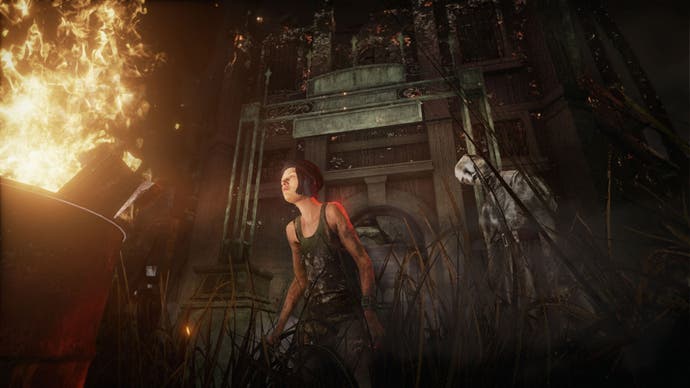
In this way, being a killer in the game is performative; you're not just carrying out gameplay objectives, you're embodying the character. Once again, this is rarely a feature of conventional horror games - as a player, you don't get to be the monster, and as soon as you encounter one, they're attacking you, you're in mortal combat. But this isn't how horror generally works; cinematic psychos play with their victims, they enjoy being voyeurs. It's the tension between the killer's gaze and the killer's fatal actions that make great horror fiction. Movie directors usually enhance this by employing a subjective camera view during moments where the killer is watching his prey - we watch through the killer's eyes, our gaze simulating his so that we too enjoy watching and waiting. The fact that the killer isn't just a mindless murdering machine is what makes him or her truly creepy. We see this brilliantly in Jaws (essentially nature's slasher flick), where, during the climactic hunt, Brody and Hooper come to believe the shark is toying with them; we also see it at the end of Alien, where Ripley realises the Xenomorph has been watching her put on a space suit. This is a frightening realisation because it gives the killer sentience. So it's fascinating that players often take on these behaviours in the game; watching, waiting, intimidating survivors. This is gaming as acting, and it's a concept we rarely see.
As an asymmetrical multiplayer title Dead by Daylight also has interesting things to say about game balance in the online era. Not only do the survivor characters all have different skills, but so do the killers, and both sets also have completely different objectives, which makes the game a giant balance conundrum. As more characters and killers are added, the relationships become even more complex. "We have an extensive metrics database and a data analyst that crunch millions of hours of gameplay into an incredible resource," says creative director, Dave Richards about the task of tweaking and iterating the game. "Thanks to the stats we can identify which area could be potentially problematic or give solid arguments towards the need or futility of a balance change."
Fascinatingly, he refers to the interplay of perks and abilities as a 'game economy' and sees the tasks of creating balance and fairness as a similar process to developing economic models: there's so much complexity and so many variables, that you can't develop a single 'right' approach to design - instead, you test theories and models. Dead by Daylight is, like a lot of multiplayer fighting games, a big sociopolitical experiment, a vast Keynesian test bed - but here the asymmetry adds an extra layer of erratic possibility. No wonder the game's reddit forums are lively.

I don't know why Dead by Daylight is more fascinating to me than Evolve or Friday the 13th, which also explore asymmetry, but at a guess, it's the clever way it uses horror tropes to create both rivalries and communities. Through its key elements - stasis, stalking, vulnerability and voyeurism - it generates highly emergent experiences. I think this modest game tells us a lot about where online player interactions are going. Video game worlds are becoming more emotionally complex, more amenable to self-expression, and more ambiguous in terms of meaning and narrative. I think the protagonists we control in shared worlds will gradually become less archetypal and more personal, and that interactions will change accordingly. Games like Dead by Daylight, DayZ and to some extent GTA Online point toward a future where relationships ebb and flow, and where deadly violence isn't always the outcome of every interaction. I think the game worlds of the near-future will also be a lot more closely governed by player-agreed rules, regulations and moral systems, and a lot less by designers. New forms of etiquette will evolve, and they may sometimes run counter to the prescribed rules of the game. It was Dead By Daylight that got me thinking about this, not Zelda or Mario. Sometimes you learn as much from weird imperfect games as you do from masterpieces.
A few nights ago, I was the last survivor remaining on a Dead by Daylight map; the killer stalked me for many minutes through the corn fields and rotten farm buildings; it was a fascinating cat and mouse encounter. At this stage in the game, an extra escape route becomes available in the shape of a trap door hidden somewhere in the terrain. But it's hard to find, and looking for it makes you visible and vulnerable. I searched, the killer stalked, the tension mounted.
Eventually, I got a message through from the other player. 'Follow me,' it said. 'I'll show you where the trapdoor is'. So I sought out the killer, fully expecting to be stabbed to death. Instead, he led me to the exit. 'Good game,' he typed.
Perhaps all players are contrarians. When we find an interesting system we want to test it; break it even. And sometimes the most subversive act is kindness. It's wonderful to find a game where despite (or perhaps even because of) thousands of hours of iteration and data analysis, such an act is possible.
